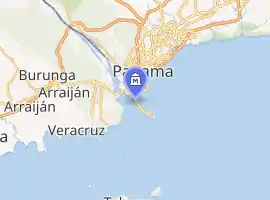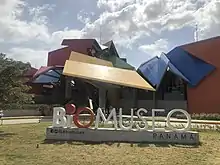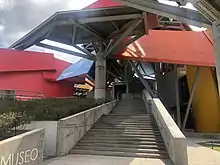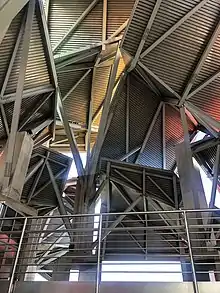Biomuseo
Biomuseo is a museum focused on the natural history of Panama, whose isthmus was formed very recently in geologic time, with major impact on the ecology of the Western Hemisphere. Located on the Amador Causeway in Panama City, Panama, it was designed by renowned architect Frank Gehry. This is Gehry's first design for Latin America. The design was conceived in 1999 and the museum opened on 2 October 2014.[1]
 | |

| |
| Established | 2 October 2014 |
|---|---|
| Location | Causeway Islands, Panama City, Panama |
| Coordinates | 8.9325°N 79.5449°W |
| Website | Official website |
The Biomuseo highlights Panama's natural and cultural history, emphasizing the role of humans in the XXI century. Its galleries tell the story of how the rise of the isthmus of Panama changed the world.
Location
Biomuseo is located in Amador, also known as Causeway, at the south entrance of the Panama Canal. You can get there taking a taxi or using the bus.


The building and its galleries
With 4,000 square meters, the Biomuseo has 8 galleries for its permanent exhibits, designed in sequence by Bruce Mau Design.[2] Besides the main spaces the museum also has a public atrium, a space for temporary exhibits, a gift store, a coffee shop and exterior exhibits in a botanical garden designed by Edwina von Gal.
On October 2, 2014 the Biomuseo opened its doors to the public with 5 of its 8 galleries. This first part of the story tells the importance of Panama and its natural and cultural evolution.
Gallery of Biodiversity:
What is biodiversity? Why should we care? What is happening to it today? The first gallery is an introduction to Panama's amazing natural heritage.
Panamarama:
We are surrounded by an endless number of living beings and communities. A three-level projection space with 10 screens envelops the visitor in a display of sight and sound featuring Panama's natural wonders.
Building the Bridge:
Panama emerged from the sea 3 million years ago. Earth's inner forces that formed the Isthmus of Panama take the form of three 14 meter high rock formations, allowing for a tangible encounter with the geological world.
Worlds Collide:
When the Isthmus closed an extraordinary exchange of species occurred between North and South America. A stampede of animal sculptures of all eras, shapes and sizes tell the story of this unique and ongoing natural event.
The Human Path:
In a space partially open to the outdoors 16 columns provide information about the relations between human activity and the natural scenarios of Panama throughout time.
The Biomuseo is expected to open its last 3 galleries by 2018.
Oceans Divided:
When Panama emerged, two very different oceans formed, changing life in the planet. Two large semi-circular aquariums will show how the Pacific Ocean and the Caribbean Sea evolved once they were separated by the isthmus.
The Living Web:
Living beings need each other and interact in complex and invisible ways. A large sculpture, part plant, animal, insect and microorganism will give the visitor the experience in a dimension where all creatures have the same importance.
Panama is the Museum:
The most amazing experience awaits the visitor outside of the museum. Screens will offer information about the relationship between the biodiversity in Panama and the world.



Social effect
The Gehry design is expected to attract tourists and help grow Panama's cultural attractions. The museum may have a similar effect as Gehry's Guggenheim design had for Bilbao, which rejuvenated and placed the city on the map as an important architectural destination.
References
- Dobrzynski, Judith H. (23 October 2014). "Biomuseo Showcases Panama's Ecological Diversity" – via www.nytimes.com.
- "Home - Bruce Mau Design". www.brucemaudesign.com.
- Germano, Celant (2010). Frank O. Gehry since 1997. New York: Rizzoli International Publications. p. 318.
- Forbes, Elise. "The panama biodiversity museum designed by frank gehry". Panama Magazine.
- Aguilera, Isabel. "Panama Biodiversity". Panama Travel Group.
